Social media platforms often create a gray area in public diplomacy. Are Twitter "likes" indicative of meaningful relationships? In a new study published by USC Annenberg's International Journal of Communication, 2017-2019...
KEEP READINGThe CPD Blog is intended to stimulate dialog among scholars and practitioners from around the world in the public diplomacy sphere. The opinions represented here are the authors' own and do not necessarily reflect CPD's views. For blogger guidelines, click here.

Selfie Diplomacy: An Analysis of MFA Profile Pictures on Twitter
As news of Brexit broke, foreign ministries throughout the world took to social media to comment on the UK’s decision to leave the EU. The German foreign ministry responded by changing its Twitter profile picture/cover photo from an image of the foreign minister to the EU flag (see below).

Studies have shown that profile pictures/cover photots on social media sites serve two main functions. The first is the creation of an online identity. Social network users employ their profile picture/cover photo to construct an identity and to communicate that identity to online communities. Secondly, profile pictures enable one to manage their online impression. Individuals can project a well-crafted image through their profile pictures/cover photos.
An intriguing question is how do MFAs use their Twitter profile pictures/cover photos. Are these used to promote the national brand, or to project a certain institutional image or perhaps to make political statements as was the case with the Germany’s foreign ministry? I have previously conceptualized MFA social media activity as a form of “Selfie diplomacy” as ministries use Twitter to manage the national image. Profile pictures/cover photos may serve as another form of selfie diplomacy through which MFAs construct their own digital identities.
To investigate how MFA utilize profile pictures, I reviewed the Twitter profile pictures/cover photos of 69 ministries. Through content analysis I was able to identify five broad categories that offer insight into the use of profile pictures/cover photos by MFAs.
Category One: Institutionalism
The first category I identified included MFAs whose profile picture/cover photo consists of the ministry’s building (see below). Such profile pictures/cover photos enable MFAs to identify themselves as professional institutions tasked with representing their nations abroad. Such institutions are home to trained practitioners who use routines and standard operating procedures to achieve their goals. Profile picture/cover photos of MFA buildings may also add credibility to social media content as such they signify that MFA tweets constitute official government statements as opposed to slogans and catchphrases.
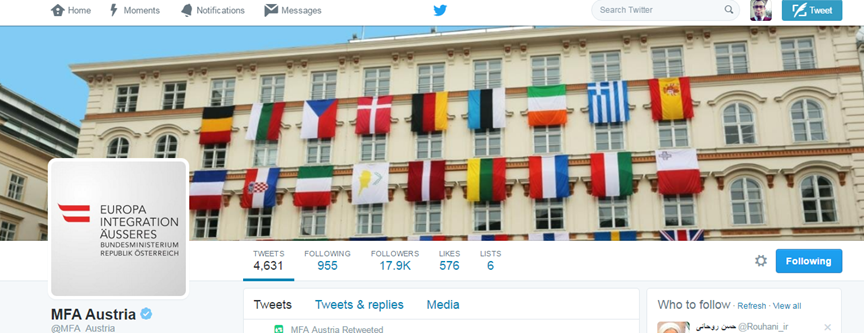
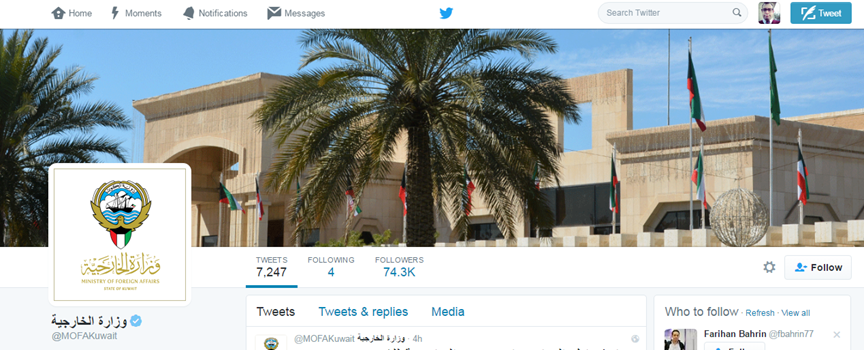
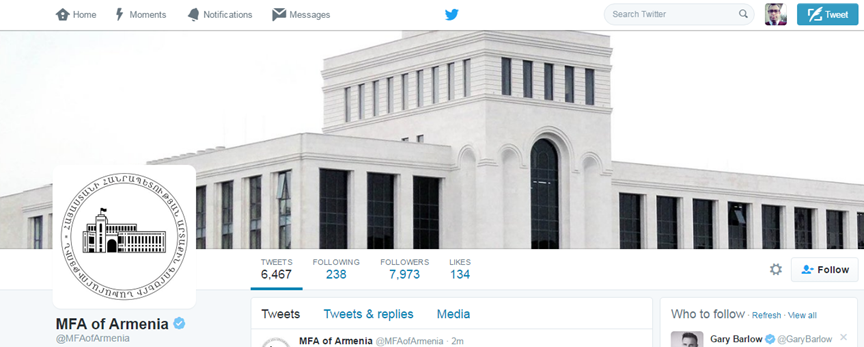
Category Two: The Mission Statement
The second category I identified included MFAs whose profile pictures/cover photos focus on the ministry’s mission- to face the world and advance a country’s interest in the global arena. Such profile pictures/cover photos may also be used to identify the character of the MFA. For instance, the image below, used by the Spanish MFA, shows its global outlook.

However, the image of the Belgium MFA seems to indicate a 21st century global outlook. This is due to the fact that the Belgium MFA’s picture corresponds with images depicting a globalized world brought together through information and communication technologies (ICTs). Thus the Belgium MFA’s selfie is one of a globally and technologically oriented ministry.

Conversely, Poland’s profile picture/cover photo projects a different mission (see image below). Two of the images included in the profile picture/cover photo showcase the U.S. flag and U.S. Secretary of State John Kerry identifying America as a strategic partner. An additional image depicts a multilateral meeting at NATO headquarters. Finally, one can see an image of two people wearing a shirt with the Polish MFA’s logo. Taken together, these images suggest that the Polish MFA’s mission is to represent Polish citizens (those wearing the T-shirt) and to protect Poland from aggression (through the U.S. and NATO).

Category Three: National Institutions
The third category includes profile pictures/cover photos that identify the MFA as a national institution that is an integral part of the nation it serves. MFAs with such images may view themselves as social institutions that are part of the society which they serve.
The first example, shown below, is the Jordanian MFA’s profile picture/cover photo that commemorates the 100 year anniversary of the Great Arab Revolt which resulted in the formation of Jordan. This image celebrates the formation of Jordan and represents the MFA as an institution that identifies with the nation.

The second example, shown below, is the profile picture/cover photo of the Icelandic MFA. The image celebrates the Icelandic soccer team’s success in the 2016 Euro games. Obviously, this is an attempt by the MFA to takes part in the national celebration and project a sense of pride in the national team’s accomplishments.
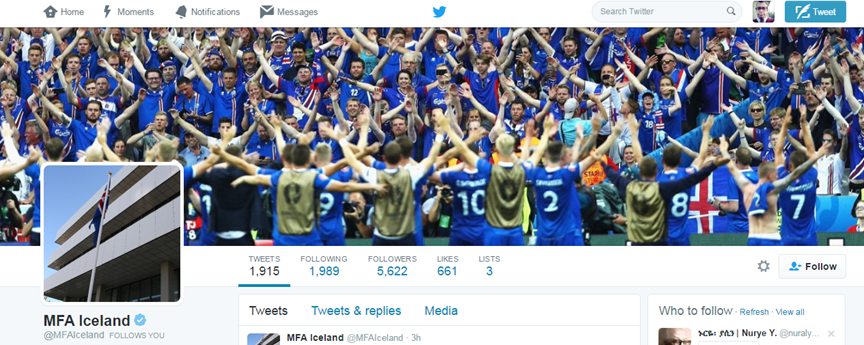
Category Four: The National Image
The fourth category I identified included MFAs who use their profile picture/cover photo to narrate the national image. Thus, these MFAs use the profile picture/cover photo to construct the national identity as opposed to their own identity. In such cases, the Twitter profile picture/cover photo becomes a diplomatic tool used for nation branding.
The first example, shown below, is the Ukrainian MFA’s profile picture/cover photo (shown below). Here the profile picture/cover photo is used to promote a new image of Ukraine as a country that is changing for the better through reforms. This may be part of an attempt to depict Ukraine as a nation transitioning from internal conflict and crisis to stability and agreement.
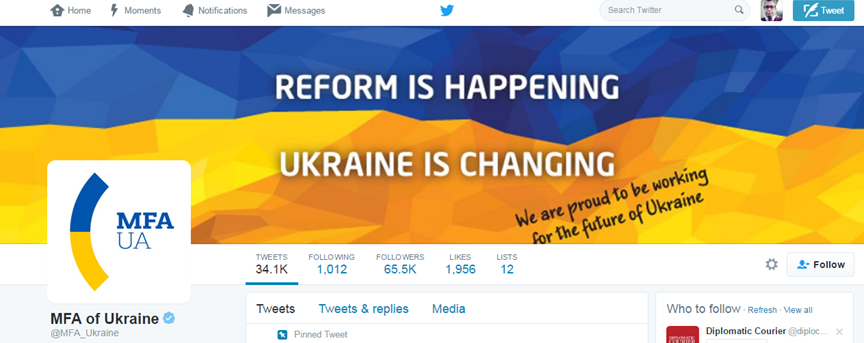
The second example is the U.S. State Department’s profile picture/cover photo. Interestingly, this image focuses solely on Secretary Kerry. Yet the image of Kerry may be seen as tied to that of the U.S., as it showcases the globetrotting Secretary who is always on his journey to promote engagement and democracy. Therefore, this image contributes to that of the U.S. as a global power that is engaged in events all over the world. What is most surprising is Kerry’s rather somber appearance. This is not the optimistic diplomat, but rather the resolute one.

Category Five: Status Updates
The fifth, and final, category I identified includes profile pictures/cover photos that serve as “status updates.” Here MFAs use the profile picture/cover photo to announce important events. By changing their profile picture/cover photo MFAs can send signals to various audiences including journalists and the diplomatic milieu.
The first example, shown below, is from the Colombian MFA and it celebrates the peace agreement between the Colombian government and the rebel group FARC.

The second example, shown below, is the profile picture/cover photo of the Mexican MFA. This picture was changed ahead of a Mexican state visit to Canada. The image is meant to demonstrate Mexico’s commitment to strong bilateral ties with Canada. Thus it is a diplomatic signal aimed at Canada and the diplomatic community.

All profile pictures/cover photos courtesy of Ilan Manor
Visit CPD's Online Library
Explore CPD's vast online database featuring the latest books, articles, speeches and information on international organizations dedicated to public diplomacy.
POPULAR ARTICLES
-
November 3
-
November 5
-
November 13
-
November 25
-
November 17
Join the Conversation
Interested in contributing to the CPD Blog? We welcome your posts. Read our guidelines and find out how you can submit blogs and photo essays >.













